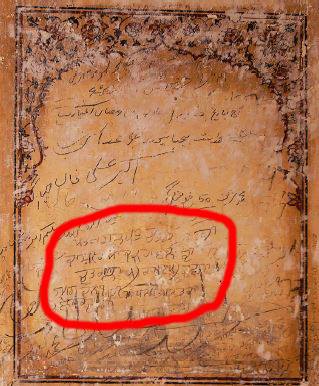In search of the remnants of the Sikh legacy in Pakistan, at Multan, a visit to the mausoleum of Hazrat Shah Shams Tabrez was a must because it was here that Nanak, the first Sikh Guru had visited in 1530. It is believed that till the partition of 1947, a memorial of Nanak’s visit had existed on the premises, no trace of which I could find.
Exiting the inner sanctum, my eyes were magnetically attracted towards scribbles on a wall. I was pleasantly surprised to find names in Gurmukhi, a script used by Sikhs which has unfortunately ceased to exist in the lands that became Pakistan. Refer scribbles circled in red in the photo. In excitement, I reached out to an aged mystic, who confirmed these date pre-1947. While I scorn people who deface heritage but these offered a vital clue that the Sikhs were once regular visitors. In that moment, I reflected there was a time when Muslim Rababis (musicians) similarly took pride in singing at the Golden Temple in Amritsar. Even though faiths may have been different but the mystics of undivided Punjab had for time immemorial attempted to transcend boundaries.
Instead of following the message of ‘singularity’ taught by the great spiritual masters of Sufism, Hinduism and Sikhism that churned on these lands, people chased the ‘duality’ professed by British educated lawyers turned political leaders of the Congress and Muslim League, which forever fractured our rich collective past.
Photographed in Jan 2017, during the research for the book “THE QUEST CONTINUES: LOST HERITAGE The Sikh Legacy in Pakistan”

